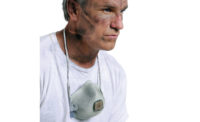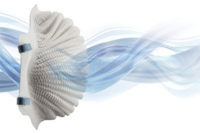Innovation in respiratory protection

Particulate respirators use similar technology to capture contaminants now as they did years ago. There are five basic mechanisms that help capture particles (see below). All these mechanisms are used by the filter, but depend upon other factors as to which mechanism is more predominant in capturing a particular particle. These factors include particle size, breathing rates (which relates to the velocity of the particle) and humidity.
Simply stated
• Impaction is where a particle has a certain amount of inertia while traveling in an air steam and tends to continue on a straight path when the direction of the air stream changes and therefore runs into the filter surface rather than passing through the porous fibers.
• Interception is where the edge of a particle comes close to a filter surface, touches it and then adheres to it.
• Sedimentation is where the air velocities are small and a particle simply tends to drop out of the air stream due to gravity.
• Diffusion is where a particle is so small in size that its movement is affected by being moved around by the natural and random movement of gases.
• Electrostatic charge is where the filter has been charged and particle of opposite charge is naturally attracted to the filter, like opposite poles of a magnet.
Recent developments
Any feature that makes a respirator more comfortable, fit better and ultimately more wearable will enhance the respirators efficacy. Some of the more recent innovations that have been developed in the last several years:
New flanges: Foam flanges are used in disposable respirators. Some are nose flanges and some full flanges. They are comfortable, light and provide an option which was only available in rubber facepiece respirators. Different materials can be used for the flanges; all enhance the comfort of the respirator and may also enhance the fit.
Ability to more easily hang the respirator around the neck: Found in disposables and reusables, the advantage is the user can hang the respirator around their neck when they are not in the contaminated area. Previously, users would have to carry it around, store it (sometimes in inappropriate places such as a contaminated bench top), or wear it uncomfortably around the neck.
Disposable NIOSH approved single-strap respirators: It’s virtually impossible to wear these respirators the wrong way. You can’t wear them with one strap not used. Plus, they don’t muss up long hair as it is much easier to don, and take off.
Increased filter area using pleats: Filter media of a disposable respirator can be pleated so it adds surface area to the disposable respirator. This technology is typically used for reusable cartridge respirators, especially the high efficiency particulate air (HEPA) cartridge filters. Adding this feature to disposable masks generally adds more breathability, lower resistance, and greater longevity of the filter.
All respirators must be fit tested, training must be conducted, and all elements of a respiratory protection program complied with. The easier, more pleasant, and comfortable you make it, the more compliance will be achieved.
Looking for a reprint of this article?
From high-res PDFs to custom plaques, order your copy today!




